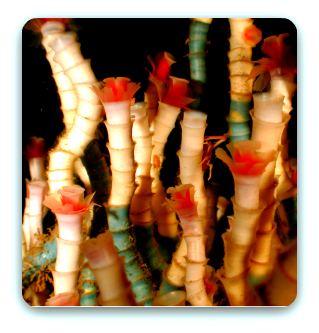|
Symbiotic relationships in herbal medicine
Introduction[Top] The word symbiosis is derived from ancient Greece; syn means with, biosis means living. Symbiosis is a term used to describe two different types of organisms that exist together in close association. There are three forms of symbiotic relationships.
Three forms of symbiosis[Top] MutualismIn these types of symbiotic relationships both organisms gain benefit. A good example of a mutulistic relationships is plants and fungus. In this relationship the fungi will live in amongst the root of the plant. This association is known as mycorrhiza. ParasitismIn parasitic relationships one organism benefits while the other organism is damaged. CommensalismIn Commensalism relationships one organism benefits while the other is not particularly helped or harmed.
Lichens[Top]
Lichens are created from a mutualistic relationship between fungi and algae. There are an estimated 30,000 lichen species around the world. Lichens can survive just about anywhere, from the arctic to the Amazon rainforest and even space. The follow video gives further information about lichen.
Lichens as medicine[Top]  Lichen has been a source of medicine for centuries. It is used in Traditional Chinese Medicine, ayurvedic medicine and other folk medicines around the world.
Lichen has been a source of medicine for centuries. It is used in Traditional Chinese Medicine, ayurvedic medicine and other folk medicines around the world.
Lichens have been used to treat constipation, alopecia, pharyngitis rabies, arthritis, kidney diseases, headaches, wounds and leprosy.
Antibiotic properties of lichen[Top] An estimated 50% of lichen species contain antibiotic properties. Usnic acid is a common component in many lichen species. It has been found to be effective against gram positive bacteria such as Pneumococcus, Staphylococcus, Streptococcus, Mycobacterium tuberculosis and other pathogenic fungi. Cordyceps sinensis[Top] Cordyceps sinensis is also known as caterpillar fungus in Tibetan it is known as yatsa gunbu or yartsa gunbu. It is the most well known species in the cordyceps genus. The cordyceps genus is a parasitic type of fungi. Caterpillar fungus is created from the parasititic relationship between the lava of the Thitarodes genus of moths and fungi.
This is a very good video that shows cordyceps infecting its host.
Cordyceps sinensis uses[Top]  Cordyceps sinensis is used and highly prized in Tibetan herbal medicine and traditional Chinese medicine.
Cordyceps sinensis is used and highly prized in Tibetan herbal medicine and traditional Chinese medicine. It is used to treat numerous ailments such as female and male dysfunction, cancer, heart, lung and kidney ailments, hiccups, pain relief, hemorrhoids, tuberculosis symptoms and to restore general appetite and health.
Cordyceps sinensis research[Top] In a study done by researchers from Taiwan and a researcher from the U.S, caterpillar fungi were found to protect mice from intestinal and bone marrow injuries after whole body irradiation. The study was published in the December 2006 Radiation Research Society journal. Cordyceps sinensis has been shown to have an antidepressant effect on mice. The study was published in the 2007 Biological and Pharmaceutical Bulletin.
Return to natural healing home
|
Loading



